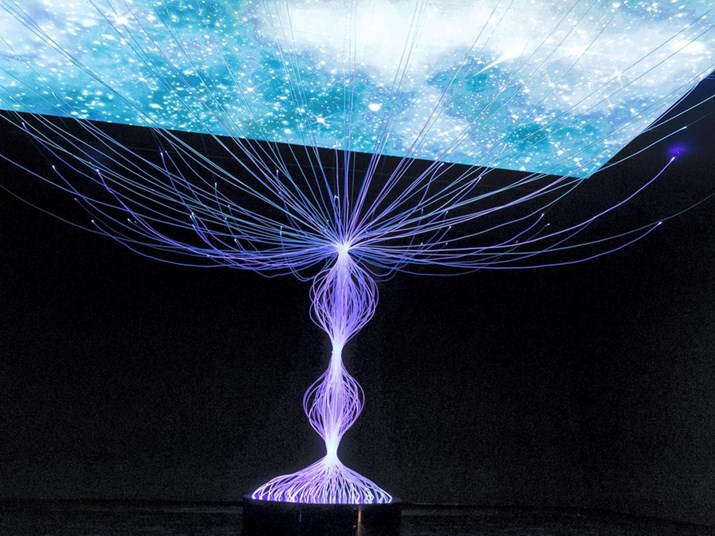
07 Jan, 2019

Almost every visitor who enters Room of Mysteries at the Sharjah Islamic Arts Festival lets out a gasp of appreciation. The darkened space, occupying an alcove of Sharjah Art Museum, contains a large ceiling screen playing a video of the constellations of the night sky from which several illuminated cords hang and are gathered together to resemble a kind of cosmic jellyfish. Emanating from every corner are the hypnotic tones of British singer-songwriter Sami Yusuf: the overall effect is magical.
The piece is a collaboration between Yusuf and Emirati artist, filmmaker and poet Nujoom Al Ghanem. It is an exploration of Islamic numerology (where certain letters correspond to specific numbers) and the mysteries of the 99 holy names of God. At the crux of the piece is the theory that reciting the names emits a vibration that increases their power. The artwork is accompanied by a booklet explaining each of the names and giving its numerical value.
It is so nuanced that it could almost stand alone as an exhibition in itself. However, it is just one of the 31 top-class artistic presentations that fill every alcove along the museum’s ground floor, the primary site of the 21st season of the festival.
Other highlights include the works of Jason Seife, an American artist whose intricate watercolour of a Persian rug hangs above a mirror as if creating an endless cycle between past and present, as well as Ahmed Keshta’s Metaphor: tessellated patterns made from ordinary pencils. Abu Dhabi artist Julia Ibbini’s laser-cut works are incredible feats of detailed precision made from layers of paper in mesmerising patterns that are coloured with vibrant tones of ink and decorated with the alluring sparkle of Swarovski crystals. They are a joy to look at and a true celebration of geometry.
Nima Nabavi, an artist from Dubai, who had his first exhibition at the emirate’s The Third Line gallery in September, presents a 64-panel piece of precise pencil-line drawings that explore his fascination with how geometry underlines every aspect of the universe, and Charles Aweida, an Arab-American artist, has created a triptych from thousands of steel nails driven into high- density foam by a robotic arm. The work, titled Particles of the Horizon, depicts a circular sun-like disc rising from behind an imagined horizon and as such, it embodies this year’s festival theme: Horizon.
“Giving the festival the title of Horizon this year is an attempt to escape directness and follow the allegories of expression and the aesthetics of meditation, resulting in the artists expanding their horizons and creating a discourse that is shaped by their inspiration of Islamic art,” says Mohammed Al Qaseer, director, Department of Culture, Sharjah, and general co-ordinator of the Sharjah Islamic Arts Festival. With this in mind, the festival is not only an exhibition of those directly rooting their practice in Islamic geometry or spirituality.
The Japanese minimalist aesthetic, which also takes its inspiration from a spiritual belief that the entire universe can be found in single particles appears in several works. Sol/Luna is a joint project between Takahiro Matsuo and Fumio Kawabe and uses mirrors and glass prisms to symbolically depict the Sun and Moon. In another quite stunning installation, Japanese artist Tomoko Ishida has folded tiny shapes from paper and attached them to taut wires inches above ground level.
Alongside the main exhibition in the Sharjah Art Museum, there are three public installations on Al Majaz waterfront: a large cupola constructed by Emirati artist Fatma Lootah; a mashrabiya-style panel by a London design collective named Toy Studio; and a mural painted by Inkman, a Tunisian artist. There are also more traditional calligraphic displays in the Sharjah Calligraphy Museum and Calligraphy Square. At Maraya Art Centre, Dana Awartani, a prominent young Saudi Arabian artist is having her first institutional show in the Middle East.
The Silence Between Us brings together pieces from Awartani’s practice and concentrates on the use of poetry and light. She also has a piece in the art museum called All [heavenly bodies] swim along, each in its orbit. It was inspired by a Quranic verse and explores the science of letters.
As with many of the works in the festival, the art itself pays homage to philosophical and spiritual thinking that characterises Islamic culture across time and geographies. Indeed, the festival’s catalogue statement describes the presentations as addressing both the visual and conceptual side of the subject. “The concept of art within the Islamic culture, is that it harmonises with Islamic thought. It reflects the absolute beauty [of God] within a visual yet abstract depiction.” Non-figurative is perhaps the one thread that would link all the pieces in the exhibition, but other than that, their influence is as broad as Islamic culture itself.
In addition, over the course of the one-month festival, 161 workshops will be held in subjects such as calligraphy, Islamic ornamentation and sand-writing, and there will be 26 public lectures on Islamic art for visitors to attend.
The combined effect of the quality exhibitions and the impressive programming is that the festival has a credible international reputation with visitors coming from around the world to witness the citywide event.
“The festival follows the path that was founded by Dr Sheikh Sultan bin Mohammed Al Qasimi, Ruler of Sharjah,” says Al Qaser. “This path is based on his beliefs in the significance of preserving art and culture, and his urge to pursue the vision of the emirate’s integrated cultural and enlightenment project.”

© 2024 Copyright Department of Culture